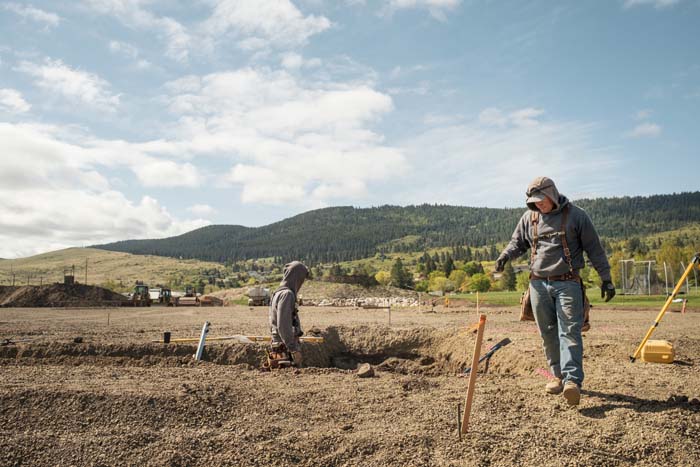Eastern Oregon University fieldhouse about eight months from completion
Published 5:00 am Tuesday, September 7, 2021

- Tom Hall (left) and Mark Lowery on Friday, May 7, 2021, prepare the foundation at the site of what will be Eastern Oregon University's fieldhouse, a multimillion-dollar facility that is expected to be ready for use by fall 2022.
LA GRANDE — The athletic skyline at Eastern Oregon University is rising.
The $9 million fieldhouse, which is currently under construction on the south side of campus, will be at least 60,000 square feet and have a top height of about 33 feet. The facility is expected to be completed by April 2022 and be ready for use by students and student athletes by fall 2022, according to John Garlitz, EOU’s director of planning and facilities.
The steel frame for the fieldhouse is nearly complete and soon exterior panels will be installed, providing the protection from the weather needed for crews to do extensive interior work this winter.
“Seeing the fieldhouse come to life is a welcome addition to our campus,” said Tim Seydel, Eastern’s vice president for university advancement. “The improved capacity and opportunities this new building brings to EOU will be felt for many years to come. It’s great to hear students talking about the new building and saying, ‘I can’t wait to get in there.’ It’s going to be awesome.”
The facility will provide space for the Mountaineers’ athletic teams to work out in the winter and other times of the year when there is inclement weather. Some EOU track athletes may view it as a second home since it will have a small track to work out on, a runway and sandpit for long jumpers and triple jumpers and pole vaulting facilities.
The structure will also house a classroom for EOU’s Health and Human Performance program that will double as a lab. In addition, the facility will be the new home of EOU’s Outdoor Adventure Program, now in the Hoke Union Building. The space for the Outdoor Adventure Program will feature a 40-by-47-foot indoor climbing center.
Upper-level features will include a mezzanine above the classroom space.
Once completed, the fieldhouse will be the largest building of its kind at any college or university in Oregon, Washington and Idaho that is not a NCAA Division I school, said Ben Welch, EOU’s head men’s and women’s track and field coach.
“It will be a difference maker for us,” he said.
Welch believes that some student athletes may not fully appreciate what is being built because many universities do not have such facilities.
“I don’t know if they totally understand the significance of this because they have nothing to compare it to,” he said.
Original designs for the building called for it to have 88,300 gross square feet, which would have allowed for a 200-meter track, making indoor track meets a possibility. However, budget constraints led to reducing the space by about 25%.
Welch said the smaller building and track still will be a big plus for his team in the winter. He said the track team conducts its winter practices in Quinn Coliseum’s small gym, which has 4,545 square feet. But in the fieldhouse, he said, his team will have access to about 48,000 square feet for practices.
The track coach said the south side of the fieldhouse will be designed so that an additional 80 feet could be added later when funding becomes available, providing the space needed to house a 200-meter track and making indoor track meets a possibility.
Garlitz said the biggest obstacle to getting the building constructed on schedule is receiving construction materials on time. He said there continues to be shipping delays because of COVID-19.
Fieldhouses are more common in the Midwest than in the Northwest, according to Welch, a University of Kansas alum. Welch had been working to help Eastern get a fieldhouse since coming to the university in the 1990s.
“It has been a long-term goal and dream,” he said. “It is nice to see it coming to fruition.”





